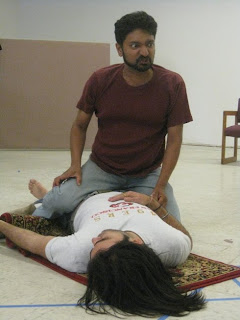(Sandeep Gawai is new to Naatak, has a small role in the play and hates all things Google....that's not going to last for too long....i am surprised he has survived so far. Anyways, I am posting for him. Yours, Rajiv Nema)
=================================
The life of Tughlaq is a life of conflict. And not just wars and rebellions. Because he has to face off not only the kingdoms of the south of
India, but also fierce, land-hungry Mongols and the Tatars.
Girish Karnad wrote this now legendary play after India had enjoyed 17 years of self-rule without any progress of note to show for it. He wrote a play of idealism degenerating into a murky morality when faced by practicality, of grand vision muddied and dragged through reality, of broken dreams. Dreams that were once articulated not just by the wise who had set out on the discovery of India, but by the common people. People, who stormed hotels and restaurants on the eve of independence which they had never dared to enter, thinking that at last that everyone was equal.
But, 1964 is a very different time from 2010. Or is it? The whole world is now a thick soup that boils in a cauldron owned by the megacorporations. And the cost of cauldron is extracted in the form of bailouts and handouts and subsidies. All pretensions of equality, fraternity, and liberty have been discarded, in favor of GDP and stock indexes.
But Tughlaq not only had to face wars and rebellions. The greater conflict, just as in our lives, is played on the psychological battlefield. Here's a deeply ambivalent emperor who has unshakable belief in Allah, but executes Imams because he cannot stand religious interference. He's a loving father to his subjects whose orders cause decimation of half of them when moving across the subcontinent. Not surprisingly, the heaviest weight on his mind is that of parricide, one of the greatest taboos. Having killed his father to become the emperor, he can never find peace with himself. So much so that he keeps reminding everyone around him of this act; even the guardsmen. He hates those who accuse him of killing his father and can't stand those who are indifferent. And in this state of mind, it's no wonder he loses his grip on reality, thus damning a rare opportunity of establishing a liberal, progressive, and visionary empire.
=============================================

































